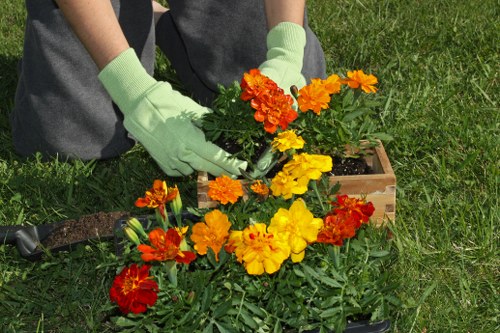Landscape Gardening in Stump Removal
Introduction to Stump Removal in Landscape Gardening

Landscape gardening is an art that transforms outdoor spaces into serene and aesthetically pleasing environments. However, one of the common challenges faced by gardeners is dealing with tree stumps. **Stump removal** is a critical aspect of maintaining a beautiful landscape, as it prevents unsightly remnants from disrupting the overall harmony of your garden.
Removing a tree stump involves more than just chopping it down. It requires careful planning and execution to ensure that the surrounding plants and soil remain unaffected. In this article, we will delve into the various methods of stump removal, their benefits, and how they integrate into landscape gardening.
Understanding the importance of stump removal can significantly enhance the appeal and functionality of your garden. Whether you’re looking to plant new trees or simply want a cleaner look, effective stump removal is essential.
Why Remove Tree Stumps?

Tree stumps can be more than just an eyesore; they can also pose several practical issues. Here are some reasons why removing stumps is beneficial:
- Safety: Stumps can be tripping hazards, especially in high-traffic areas of your garden.
- Health of the Garden: Decaying stumps can attract pests and fungi, which may spread to other plants.
- Aesthetic Appeal: Removing stumps contributes to a cleaner and more organized garden appearance.
- Space Utilization: Eliminating stumps frees up space for new plants, shrubs, or other garden features.
Addressing stump removal proactively ensures that your landscape remains healthy and visually appealing.
Effective stump removal is not just about aesthetics; it’s about maintaining the overall health and functionality of your garden.
Methods of Stump Removal

1. Manual Removal
Manual stump removal involves physically digging out the stump and its roots. This method is labor-intensive but environmentally friendly.
Advantages
- No use of chemicals or machinery.
- Complete removal of the stump and roots.
- Provides land that can be used immediately for other purposes.
Disadvantages
- Time-consuming and requires significant effort.
- May require specialized tools.
- Not ideal for large or deeply rooted stumps.
Manual removal is best suited for small to medium-sized stumps where machinery is not necessary.
Chemical Stump Removal

Chemical stump removal involves applying chemicals that accelerate the decomposition process of the stump.
Common Chemicals Used:
- Potassium nitrate
- Glyphosate herbicide
- Fermcol
After applying the chemicals, the stump typically breaks down over several weeks to months, making it easier to remove the remaining wood.
Note: It’s important to follow the manufacturer’s instructions and safety guidelines when using chemical treatments.
Mechanical Stump Removal

Grinding
Stump grinding uses specialized machinery to mill the stump into small wood chips. This method is efficient and can quickly remove large stumps.
Advantages
- Fast and effective for large stumps.
- Minimal impact on surrounding vegetation.
- Produces mulch that can be reused in the garden.
Disadvantages
- Requires access to machinery.
- Can be expensive compared to manual methods.
- Noise and disruption from equipment.
Stump grinding is a popular choice for homeowners seeking a quick and clean solution to stump removal.
Natural Decomposition
Allowing the stump to decompose naturally is the most eco-friendly method, though it takes the longest time.
Steps to Facilitate Decomposition
- Drilling Holes: Create holes in the stump to increase surface area.
- Applying Accelerants: Use organic materials or sprays to speed up decomposition.
- Maintaining Moisture: Keep the stump moist to encourage fungal growth.
This method requires patience but avoids the need for physical removal or chemical treatments.
Benefits
- Environmentally friendly.
- Provides habitat for wildlife.
- Enriches the soil as the stump breaks down.
Integrating Stump Removal into Landscape Design
Effective stump removal is just one aspect of landscape gardening. Integrating stump removal seamlessly into your garden design can enhance the overall beauty and functionality of your outdoor space.
- Plant Replacement: After removing a stump, consider planting a new tree or shrub to maintain greenery.
- Hardscaping: Use the cleared space for patios, pathways, or other structural elements.
- Mulching: Utilize the wood chips from stump grinding as mulch to suppress weeds and retain soil moisture.
Thoughtful integration of stump removal ensures your garden remains both beautiful and practical.
Consider consulting with a professional landscaper to plan the best approach for your specific needs.
Choosing the Right Stump Removal Method
Selecting the appropriate stump removal method depends on various factors, including the size of the stump, location, budget, and personal preferences.
- Evaluate the Size and Type: Larger stumps may require mechanical removal, while smaller ones can be handled manually.
- Assess the Location: Stumps near structures or walkways might necessitate a less invasive method.
- Budget Considerations: Manual and natural methods are often more cost-effective, whereas mechanical grinding can be pricier.
- Time Constraints: If immediate removal is needed, mechanical methods are preferable.
By carefully evaluating these factors, you can choose the most efficient and suitable stump removal process for your landscape.
Professional advice can greatly assist in making the right decision.
Post-Removal Landscape Maintenance
After removing a stump, proper maintenance ensures the longevity and health of your garden.
- Soil Restoration: Refill any holes and amend the soil as needed to support new plant growth.
- Planting: Introduce new plants to replace the removed tree, ensuring they are suitable for your garden’s conditions.
- Mulching: Apply mulch to conserve moisture, regulate soil temperature, and prevent weed growth.
Maintaining the area post-removal helps in quickly restoring the aesthetic and functional aspects of your landscape.
Regular inspections can prevent future issues and keep your garden thriving.
Environmental Considerations
Sustainable practices in stump removal contribute positively to the environment. Choosing eco-friendly methods minimizes the ecological footprint of your gardening activities.
- Using Natural Decomposition: Promotes biodiversity and enriches the soil naturally.
- Recycling Wood Chips: Utilize the byproducts of stump grinding as mulch or compost.
- Avoiding Harmful Chemicals: Opt for non-toxic alternatives to protect soil health and surrounding plants.
Embracing environmentally responsible stump removal practices ensures your garden remains a sustainable and vibrant space.
Implementing green practices aligns your landscape gardening efforts with broader ecological goals.
Cost Factors in Stump Removal
The cost of stump removal varies based on the chosen method, size of the stump, and other factors.
- Manual Removal: Typically lower cost but labor-intensive.
- Chemical Treatment: Moderate cost with recurring expenses for treatments.
- Mechanical Grinding: Higher upfront cost but quick and efficient.
- Natural Decomposition: Minimal cost but requires time.
Understanding the cost implications helps in budgeting and selecting the best method for your needs.
Get quotes from multiple professionals to ensure you receive the best value for your stump removal project.
Hiring Professionals vs. DIY
Deciding between professional stump removal and a do-it-yourself approach depends on your expertise, resources, and the specific requirements of your garden.
Advantages of Hiring Professionals
- Experience and expertise ensure effective removal.
- Access to specialized equipment.
- Time-saving and less physical effort.
- Guaranteed safety and compliance with regulations.
Advantages of DIY Stump Removal
- Cost savings on labor.
- Flexibility in choosing methods.
- Satisfaction from completing the task yourself.
- Ability to work at your own pace.
Weighing these factors can help you make an informed decision that aligns with your capabilities and garden needs.
Consider the complexity of the task before deciding to undertake stump removal yourself.
Tools and Equipment for Stump Removal
Having the right tools is essential for effective stump removal. Whether you opt for manual or mechanical methods, the appropriate equipment can make the process more efficient.
- Axes and Saws: For cutting through the stump manually.
- Digging Tools: Shovels and mattocks for removing roots.
- Stump Grinder: A powerful machine for grinding stumps into mulch.
- Chemical Sprayers: For applying decomposition accelerants.
Investing in quality tools ensures safety and effectiveness during the stump removal process.
Proper maintenance of tools extends their lifespan and performance.
Safety Precautions
Stump removal can be hazardous if proper safety measures are not followed. Ensuring safety protects not only you but also those around you.
- Protective Gear: Always wear gloves, safety goggles, and sturdy footwear.
- Clear the Area: Remove any obstacles or objects that could cause accidents.
- Use Tools Correctly: Follow manufacturer instructions and guidelines for all tools and equipment.
- Be Cautious with Chemicals: Handle chemical treatments with care to avoid harm to yourself and the environment.
Adhering to these safety precautions minimizes risks and ensures a smooth stump removal process.
Remember: Safety should always be a top priority in any gardening task.
Benefits of Professional Stump Removal Services
Professional stump removal services offer numerous advantages that can enhance your landscape gardening experience.
- Expertise: Professionals have the knowledge and skills to handle various stump removal scenarios.
- Efficiency: With the right equipment, they can complete the job quickly and effectively.
- Comprehensive Services: Many professionals offer additional services such as land leveling, soil restoration, and plant replacement.
- Warranty and Guarantees: Reputable services often provide guarantees on their work.
Hiring professionals ensures that stump removal is handled properly, allowing you to focus on other aspects of your garden.
Contact us today to schedule a professional stump removal service and transform your landscape.
Environmental Impact of Stump Removal
Considering the environmental impact of your stump removal method is essential for sustainable landscape gardening.
Sustainable Practices
- Reuse Materials: Utilize wood chips and mulch from stump grinding in your garden.
- Minimize Chemical Use: Opt for natural decomposition methods when possible.
- Promote Biodiversity: Maintain healthy soil and plant diversity by choosing eco-friendly removal methods.
Implementing these sustainable practices ensures that your garden thrives while respecting the environment.
Eco-conscious stump removal contributes to a healthier and more resilient garden ecosystem.
Conclusion
Stump removal is a pivotal component of landscape gardening that enhances both the beauty and functionality of your outdoor space. By understanding the various methods available, their benefits, and how they integrate into your garden design, you can make informed decisions that best suit your needs.
- Assess the size and location of the stump.
- Choose a removal method that aligns with your budget and time constraints.
- Consider the environmental impact of your chosen method.
- Maintain the area post-removal for a thriving garden.
Whether you opt for manual removal, chemical treatments, mechanical grinding, or natural decomposition, each method has its unique advantages and considerations. **Contact us today** to explore professional stump removal services that can help you achieve the perfect landscape garden you've always desired.
Book your service now and take the first step towards a stunning and well-maintained garden.